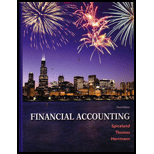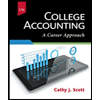
Trade discount:
Seller of a product or service offers a reduction in the listed price of the product or service, such reduction is known as trade discount.
Sales discount:
Seller of a product or service offers a reduction in the (
To explain: The difference between the trade discount and sales discount.
Sales discount:
Seller of a product or service offers a reduction in the (accounts receivable) amount to be paid by the customer, only if the customer makes payment within a specified period of time, such reduction is known as sales discount.
To describe: The location in which sales discounts are reported in the income statement.
Want to see the full answer?
Check out a sample textbook solution
Chapter 5 Solutions
Financial Accounting
- Please explain the correct approach for solving this financial accounting question.arrow_forwardPlease explain the solution to this general accounting problem with accurate explanations.arrow_forwardI need help finding the accurate solution to this general accounting problem with valid methods.arrow_forward
- Paramount Studios earned $18,500 in revenue during the month, but only $16,000 had been received in cash by month-end. The company’s only expense was salaries of $5,700, which will be paid next month. How much did Paramount report in net income for the month?arrow_forwardCan you explain the correct approach to solve this financial accounting question?arrow_forwardPlease provide the accurate answer to this general accounting problem using valid techniques.arrow_forward
- I want to this question answer for financial accounting question not need ai solutionarrow_forwardPlease provide the accurate answer to this general accounting problem using appropriate methods.arrow_forwardI need assistance with this general accounting question using appropriate principles.arrow_forward
- Can you help me solve this Financial accounting problem using the correct accounting process?arrow_forwardI am searching for the correct answer to this general accounting problem with proper accounting rules.arrow_forwardCan you help me solve this general accounting problem using the correct accounting process?arrow_forward
 College Accounting, Chapters 1-27AccountingISBN:9781337794756Author:HEINTZ, James A.Publisher:Cengage Learning,
College Accounting, Chapters 1-27AccountingISBN:9781337794756Author:HEINTZ, James A.Publisher:Cengage Learning, Cornerstones of Financial AccountingAccountingISBN:9781337690881Author:Jay Rich, Jeff JonesPublisher:Cengage Learning
Cornerstones of Financial AccountingAccountingISBN:9781337690881Author:Jay Rich, Jeff JonesPublisher:Cengage Learning College Accounting, Chapters 1-27 (New in Account...AccountingISBN:9781305666160Author:James A. Heintz, Robert W. ParryPublisher:Cengage Learning
College Accounting, Chapters 1-27 (New in Account...AccountingISBN:9781305666160Author:James A. Heintz, Robert W. ParryPublisher:Cengage Learning- Century 21 Accounting Multicolumn JournalAccountingISBN:9781337679503Author:GilbertsonPublisher:Cengage
 College Accounting (Book Only): A Career ApproachAccountingISBN:9781337280570Author:Scott, Cathy J.Publisher:South-Western College Pub
College Accounting (Book Only): A Career ApproachAccountingISBN:9781337280570Author:Scott, Cathy J.Publisher:South-Western College Pub




